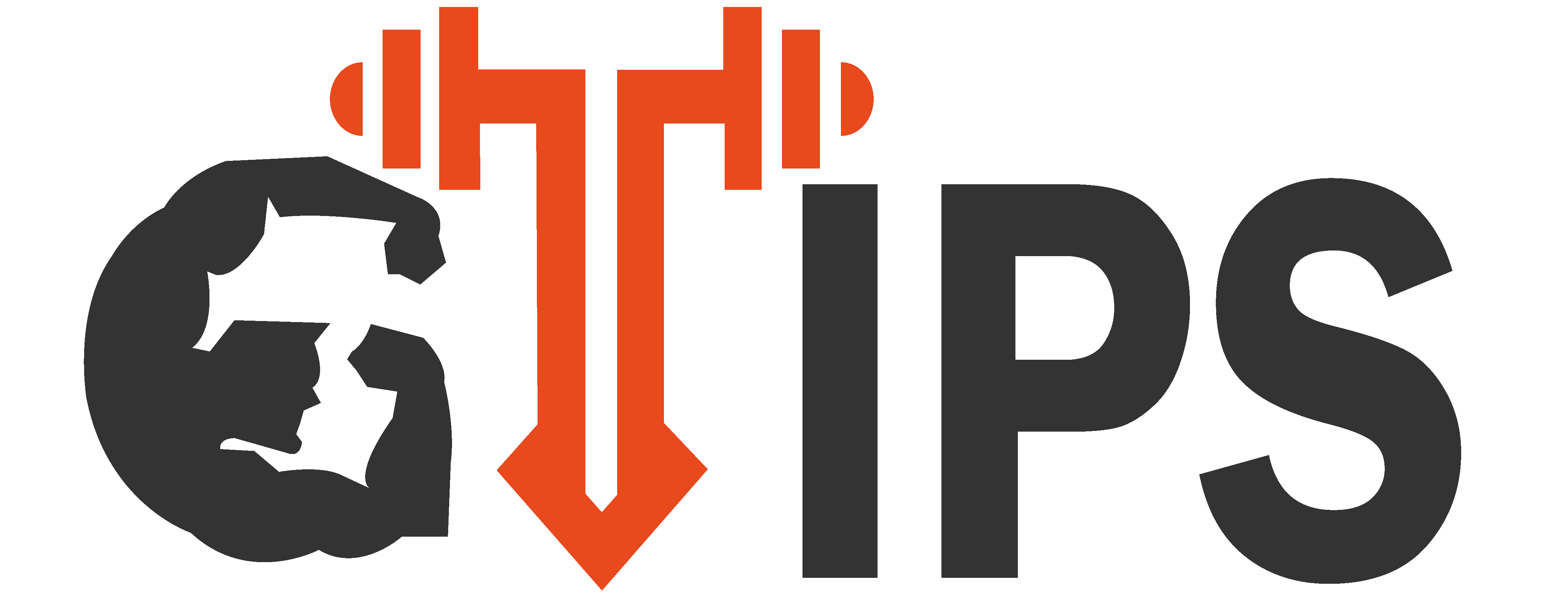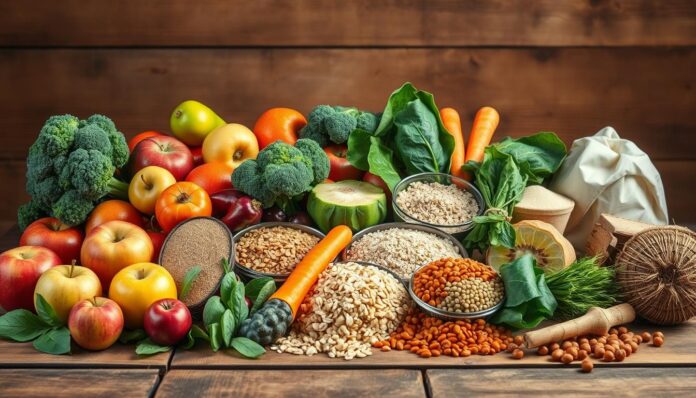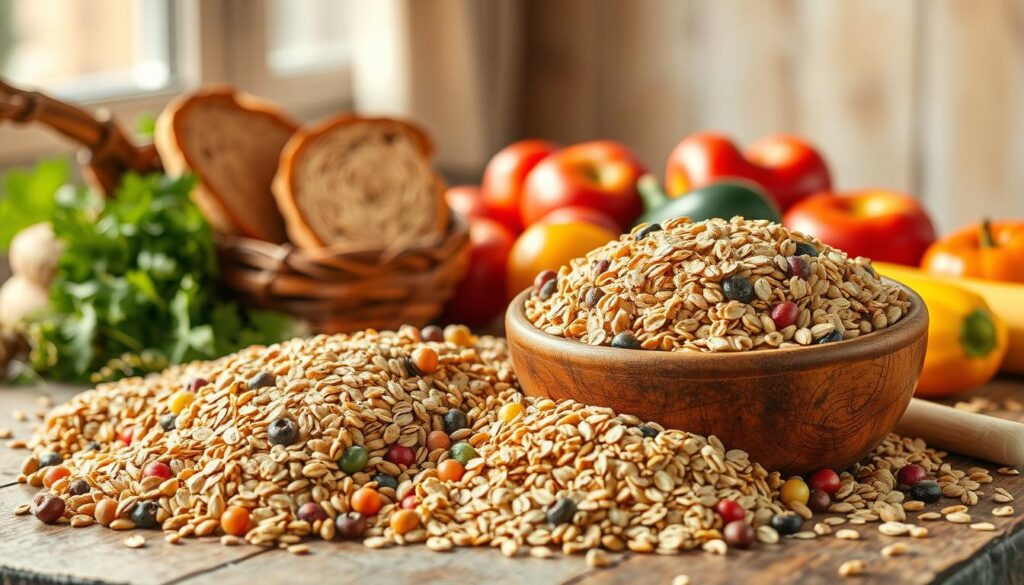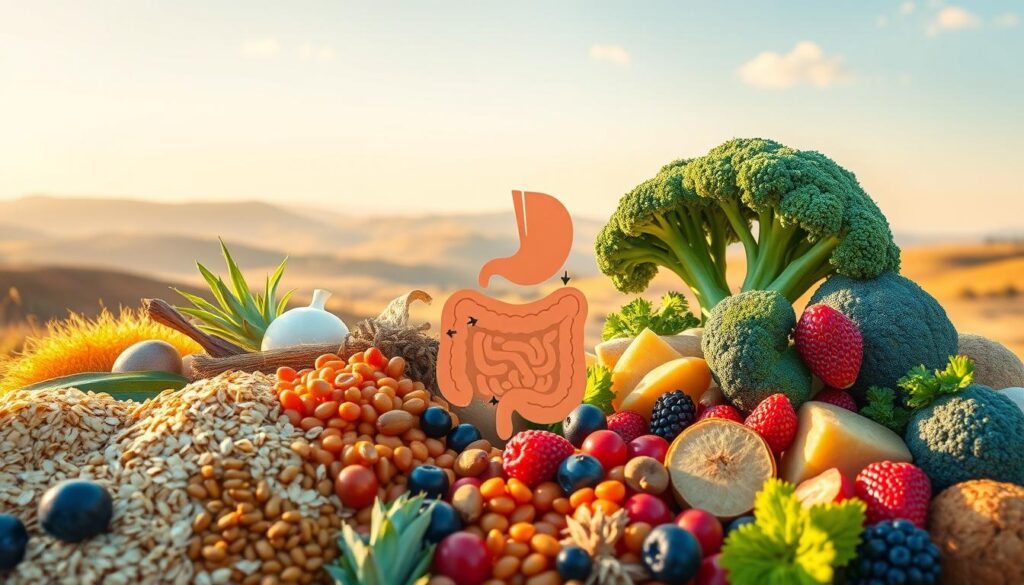Ever wondered why digestive issues keep coming back? It might be because you’re not getting enough fiber. Adding high-fiber foods to your diet can change your digestive health and overall health. You’ll learn how a diet rich in fiber can prevent constipation, improve gut health, and lower the risk of digestive problems. Plus, you’ll find out which foods are best for your digestive health.
Key Takeaways
- The daily recommended fiber intake is between 30 to 41 grams for good digestion.
- Incorporating high-fiber foods can significantly improve your digestive health.
- Fruits like berries and apples are excellent sources of dietary fiber.
- Vegetables such as broccoli and carrots can boost your fiber intake.
- Whole grains like quinoa and oatmeal contribute significantly to a balanced diet.
- Legumes, including beans and lentils, are powerful sources of fiber.
Understanding Dietary Fiber
Dietary fiber is key to a healthy diet, coming mainly from plants. It plays a big role in digestion, boosting your health. Knowing about fiber helps you choose better foods and snacks.
The Importance of Fiber in Your Diet
Fiber is very important. It keeps your bowels regular, lowers disease risks, and helps with weight. Adding fiber makes you feel full and helps your body digest food better. It also helps good bacteria grow in your gut.
Types of Dietary Fiber
There are two main types of fiber. Soluble fiber dissolves in water, lowering cholesterol and blood sugar. You can find it in oats, fruits, and legumes.
Insoluble fiber doesn’t dissolve and helps keep your stool regular. You can find it in whole grains, nuts, and veggies. Eating different types of fiber improves your gut health and nutrition.
Benefits of High-Fiber Foods for Digestion
High-fiber foods are great for digestion. They help prevent many digestive problems and improve gut health. Adding more fiber to your diet can be very beneficial.
Preventing Constipation
High-fiber foods are key in avoiding constipation. They make stool bulkier and softer, making bowel movements easier. This reduces the chance of issues like hemorrhoids and diverticulitis. Getting enough fiber keeps you regular and comfortable.
Promoting Gut Health
High-fiber foods also boost gut health. They feed good bacteria in the gut, helping it function better. This can even lower the risk of colorectal cancer. Choosing fiber-rich foods is good for your gut.
Lowering the Risk of Digestive Disorders
Eating high-fiber foods can lower the risk of digestive disorders. Research shows fiber helps prevent diseases like inflammatory bowel disease and diverticular disease. Fiber-rich foods strengthen your digestive system and protect against future problems.
High-Fiber Foods for Digestion
Eating foods high in fiber can really help your digestion. Many fruits and vegetables are full of fiber, which is great for digestion. Choosing the right foods can make your body work better.
Top Fruits with High Fiber Content
Fruits with lots of fiber are tasty and good for you. For example:
- A cup of raspberries has about 8 grams of fiber.
- A medium pear has around 5.5 grams of fiber.
- Apples, with their skin, give you about 4 grams of fiber per medium fruit.
- Bananas and oranges are also great, adding a lot to your fiber intake.
Vegetables to Boost Your Fiber Intake
Vegetables are key for a fiber-rich diet. They’re easy to add to your meals. Here are some good ones to try:
- Green peas have 9 grams of fiber per cooked cup.
- Broccoli gives you about 5 grams of fiber per cup.
- Brussels sprouts have around 4 grams of fiber per cooked cup.
Healthy Grains: A Source of Fiber
Adding healthy grains to your diet is key for a fiber-rich diet. Whole grains offer important nutrients and fiber. Refined grains, on the other hand, are processed and lack these benefits. Knowing the difference helps you choose better foods.
Whole Grains vs. Refined Grains
Whole grains like brown rice and quinoa keep their bran and germ. This means they are full of fiber. Refined grains, such as white rice, lose these parts during processing. They have less fiber and nutrients.
Eating whole grains boosts your fiber intake. It also supports your overall health.
Incorporating Grains into Your Meals
To get the most from healthy grains, add them to different meals. Begin with a fiber-rich breakfast using whole-grain cereals or oatmeal. For lunch or dinner, switch to brown rice or add barley or quinoa to your dishes.
These changes help your digestion and follow a balanced diet. Try new ways to add grains to your meals for a healthier lifestyle. Check out this resource for more on healthy eating.
Legumes: Nature’s Fiber Powerhouses
Legumes, like beans, lentils, and peas, are key to a fiber-rich diet. They are full of nutrients, making them great for your health. Eating legumes regularly helps with digestion because of their high fiber content.
Different Types of Beans and Their Benefits
There are many types of beans, each with its own health perks. Adding them to your meals can greatly improve your health. Here are some popular ones:
- Black Beans: Known for their rich flavor and protein, black beans have about 15 grams of fiber per cup.
- Kidney Beans: With their vibrant color, kidney beans are full of nutrients, just like black beans.
- Lentils: Lentils have about 15.5 grams of fiber per cooked cup. They’re great in soups and salads.
- Pinto Beans: These beans add a creamy texture and have around 15 grams of fiber. They’re perfect for any diet.
How to Add Legumes to Your Diet
It’s easy and tasty to add legumes to your meals. Here are some ways to do it:
- Add legumes to soups and stews for extra nutrition and thickness.
- Put them in salads for a hearty texture and flavor.
- Use pureed beans as a base for dips, boosting fiber and reducing unhealthy fats.
- Swap meat with legumes in your favorite dishes for a fiber-rich, plant-based meal.
Incorporating Nuts and Seeds into Your Diet
Nuts and seeds are great for your diet. They are full of nutrients and help your digestive health. They add flavor to your meals and boost your overall health, thanks to their fiber.
There are many choices like almonds, walnuts, chia seeds, or flaxseeds. You can pick what you like best.
The Fiber Content in Nuts
Nuts are known for their fiber content. This fiber is good for your digestive health. For example, almonds have about 3.5 grams of fiber per ounce.
Walnuts and pistachios also have a lot of fiber. This fiber helps keep your digestion regular and prevents constipation.
Benefits of Seeds for Digestive Health
Seeds like chia and flaxseed are very fiber-rich. Chia seeds have about 10 grams of fiber per ounce. They are excellent for your digestive system.
The soluble fiber in these seeds helps your gut. It absorbs water and forms a gel, making you feel full and slowing digestion. Eating nuts and seeds for health boosts your fiber intake and improves your digestive health.
Delicious High-Fiber Recipes
Creating high-fiber recipes can make your meals both fun and nutritious. These dishes boost your fiber intake and taste great. You can find tasty options for breakfast, snacks, and main courses.
Quick Breakfast Ideas
Begin your day with energizing meals that are rich in fiber. Try these:
- Oatmeal topped with fresh berries and a sprinkle of nuts
- Greek yogurt mixed with chia seeds and sliced peaches
- Whole grain toast slathered with avocado and garnished with pumpkin seeds
Healthy Snack Options
Adding healthy snacks to your diet keeps your energy up. Enjoy these tasty options:
- Raw vegetables like carrots and bell peppers served with hummus
- A fruit smoothie blended with spinach and your favorite fruits
- Apple slices paired with almond butter for a sweet crunch
Fiber-Rich Lunch and Dinner Recipes
Enjoy hearty meals that are high in fiber. Here are some great choices:
- Salad with a base of leafy greens, topped with chickpeas and diced vegetables
- Whole grain wraps filled with grilled chicken, spinach, and roasted peppers
- Quinoa bowl mixed with black beans, corn, and avocado
Fiber Supplements for Digestion
Getting enough fiber can be hard, even with a good diet. Fiber supplements help those who find it tough to get enough fiber. They improve digestion and help with stomach problems.
When to Consider Fiber Supplements
Think about fiber supplements if you don’t get enough fiber. This could be because of diet limits, stomach issues, or wanting to eat more fiber. Always talk to a doctor before starting any supplements. They can pick the right one for you.
Types of Fiber Supplements Available
There are many fiber types, each with its own role. Soluble and insoluble fibers are the main kinds. Here are some common ones:
| Supplement Type | Soluble or Insoluble | Benefits |
|---|---|---|
| Psyllium Husk | Soluble | Helps with constipation and regulates bowel movements |
| Methylcellulose | Soluble | Effectively softens stool |
| Wheat Dextrin | Soluble | May enhance overall digestive health |
| Inulin | Soluble | Acts as a prebiotic, promoting gut bacteria growth |
| Chicory Root | Insoluble | Supports bowel regularity and gut health |
Hydration: The Key to Fiber’s Effectiveness
It’s important to understand how hydration and fiber work together for good digestion. Water helps fiber move through your body smoothly. This prevents discomfort and keeps your bowel movements regular.
The Role of Water in Digestive Health
When you eat more fiber, water and fiber team up to help your body. Drinking enough water keeps your stool soft and easy to pass. Without enough water, fiber can cause bloating and discomfort. So, drink water all day to stay comfortable.
Adding hydration and fiber to your diet has many benefits for your gut. Make sure to drink plenty of water with foods high in fiber like fruits and whole grains. Taking care of your digestive health means staying hydrated and eating enough fiber.
Gradually Increasing Your Fiber Intake
When you think about adding more fiber, do it slowly. Quick changes can upset your stomach. Start with small amounts of fiber-rich foods in your meals. This lets your body adjust without discomfort.
How to Add Fiber Slowly to Your Diet
Start by adding fiber a little at a time. Here are some steps to help you:
- Begin with small portions of foods high in fiber, like fruits, veggies, and whole grains.
- Blend fiber-rich ingredients into dishes you already like. This makes it easier to get used to.
- Slowly increase how much of these foods you eat over time.
- Keep a food diary to track how much fiber you’re getting and any changes.
Listening to Your Body’s Signals
It’s important to watch how your body reacts. Notice any changes in digestion and how you feel. Signs you’re adjusting well include:
- More regular bowel movements
- Less bloating and gas
- Feeling better overall and having more energy
By paying attention to how you feel, you can make choices that keep you healthy and happy.
Addressing Possible Digestive Issues
When you eat more fiber, you might feel some digestive problems. These can include gas and bloating. These issues often happen when you change your diet too fast. It’s important to know how your body reacts to fiber to make your diet change easier.
Gas, Bloating, and Other Side Effects
Feeling uncomfortable in your stomach is common when you start eating more fiber. Symptoms like gas and bloating come from fiber being broken down in your intestines. You might also feel cramps or be too full, which can be uncomfortable.
Watching how these symptoms affect your daily life is key. It’s a good idea to slowly increase your fiber intake.
When to Seek Medical Advice
If you keep feeling bad in your stomach for more than a few days, you should see a doctor. Long-lasting or getting worse symptoms might mean you have a health issue. A doctor can help you understand what’s going on and guide you in making the right diet changes.
It’s vital to think about your own digestive health. You want your fiber changes to make you feel better, not worse.
Conclusion
Eating foods high in fiber is key for good digestion and a healthy gut. Foods like fruits, veggies, whole grains, legumes, nuts, and seeds are full of nutrients. They help keep your digestive system running smoothly and prevent constipation.
Creating a meal plan with lots of fiber is easy. You can add these healthy foods to your daily meals without much effort. As you make these changes, you’ll notice your digestion getting better and feel more energetic.
Choosing high-fiber foods is a smart way to keep your digestive system healthy for life. Start now and enjoy the many benefits of a diet rich in fiber!






